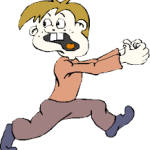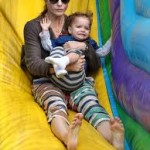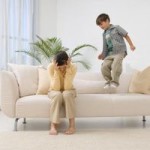Brainwaves is a monthly newsletter designed to create some “brainwaves” within my community of colleagues, friends and clients.
“More movement” … a common sensory strategy
I frequently read or hear strategies that encourage caregivers or teachers to add more movement into their child’s day. These are often aimed at helping the individual who has strong needs to move. There is an increased focus on movement in our culture and a growing awareness that our bodies and brains NEED to move to learn. However there are times when this strategy does not work and seems to make matters worse!
1) Stress causes the movement
Most of us will need to move if something triggers the stress response or the “fight, flight or fright” behaviors.
If your child (or adult) is moving their body in an effort to escape or protect themselves, they need to move their body into an environment that  they perceive as safe and regulating at that moment.
they perceive as safe and regulating at that moment.
Solution? Of course, the focus should be on NOT triggering this type of movement in the first place. A careful analysis of your child/adult’s behavioral triggers will help you to better understand what might be going.
Another suggestion might be to add more heavy muscle work or deep pressure touch into the movement.
2) Movement causes stress
Did you know … that forcing people who are highly sensitive to movement to move, will actually trigger the fight, flight, fright reaction? Children or adults who are highly sensitive to movement usually prefer sit down tasks. They may not like swinging or rocking, being off the ground, riding in a car, running, jumping, walking on uneven ground, stairs, escalators/elevators, etc. They often experience a lot of anxie ty about life in general.
ty about life in general.
Solution?
These folks will benefit from exercise like all of us but needs it to be predictable and within their comfort zone. They might prefer individualized activities or ones that do not require a great deal of head movement through space i.e.) exercise bikes or other machines, walking on a track. An occupational therapist can help you to better understand individuals that are sensory over-responsive.
3) Don’t know what to do….seek movement!
If your child (or adult) seems to be seeking movement it might be because they don’t know how to make sense of a situation or don’t know how to structure their time. In essence, this uncertainty can trigger the stress response. 
Did you know … that in this situation, these individuals actually become MORE DISORGANIZED the more that they move? Although they are seeking movement, their brain actually does not know what to do with it.
Solution?
These folks need movement but they need movement to be structured and goal directed, not random. Including heavy muscle work and deep pressure touch can also be helpful. Examples;
- In the classroom or at home; counting by 2’s, or 5’s while doing jumping jacks; move while singing a song with specific movements; Simon says; here is an online source for cooperative games at home http://www.creativekidsathome.com/games/cooperative_games/
- Engage adults in completing chores or following simple movement activities/exercises; go for a walk with a destination in mind or do a circuit, doing a “theme” walk
- In the gym; running back and forth putting beanbags in a bucket, following a circuit during Jungle gym
- On the playground; doing a specific circuit on the play structure, then change the order of the circuit; designated sidewalk games that have been pre-taught; cooperative games (there are lots of ideas for cooperative games on the internet, here is one source http://www.teachhub.com/6-awesome-cooperative-classroom-games
Information on vestibular over-responsiveness or defensiveness
